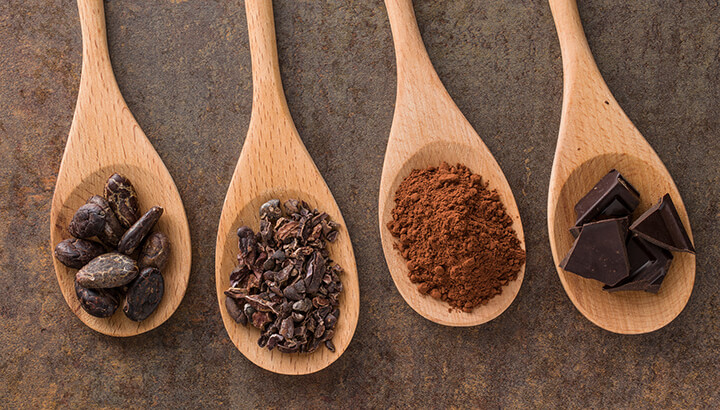
Chocolate in the medicine cabinet? While the thought may make you chuckle, this statement may not be too far off.
Of course, the majority of the candy bars at candy stores, grocery stores, convenience stores and gas stations rightly belong in the junk food aisle. Most chocolate in this country is so highly processed, and so loaded with sugar and artificial chemicals, that it doesn’t resemble anything healthy at all.
However, organic, raw dark chocolate is a potent medicinal superfood. A large body of research exists to back its multitude of healing properties.
First, the nutritional content. Chocolate contains a variety of B-vitamins, including B1, B2, B3, B5, and B8. B-vitamins are essential for many of the body’s functions, throughout various systems. It also contains vitamin E, a powerful antioxidant associated with optimal skin, hair and nail health. On top of that, it is a source of both protein and fiber.
Chocolate is also a good source of healthy fats, including nutritious, natural saturated fats. It also contains oleic acid, a monounsaturated fat also found in coconut oil and olive oil. Chocolate contains phenylethylamine (PEA), which is linked to elevating mood. There’s also theobromine, an alkaloid which may help provide the body with energy by stimulating the central nervous system.
Last but not least, it’s teeming with flavonoid antioxidants. These inflammation and free radical-fighting antioxidants are thought to be the main reason that chocolate is linked to so many health benefits. What benefits, you ask? Read on…
Heart health
Evidence for chocolate’s beneficial effects on the cardiovascular system has been compounding rapidly over the last few years. The following is a brief look at a few of the many recent studies on this topic.
2011 Research
In a 2011 study published in the British Medical Journal, researchers from the University of Cambridge linked eating high amounts of chocolate to a one-third lesser risk of developing cardiovascular disease. Researchers arrived at these results by analyzing seven previous studies, which included a total of over 100,000 volunteers.
On their results, the researchers stated:
“… [the] highest levels of consumption were associated with a 37 percent reduction in cardiovascular disease and a 29 percent reduction in stroke compared with lowest levels.”
Further, the researchers concluded:
“Based on observational evidence, levels of consumption seem to be associated with a substantial reduction in the risk of cardiometabolic disorders. Further experimental studies are required to confirm a potentially beneficial effect of chocolate consumption.”
2014 Research
Researchers have performed more studies on chocolate, of various designs, since 2011. The authors of a 2014 study published in the British Journal of Nutrition wrote:
“The consumption of cocoa and dark chocolate is associated with a lower risk of CVD [cardiovascular disease], and improvements in endothelial function [the function of the inner lining of blood vessels] may mediate this relationship. “
The study authors then tested its effect on the peripheral arteries of overweight individuals. Researchers recruited 30 volunteers, all of whom were middle-aged and overweight. Researchers asked them to consume substantial amounts of dark chocolate and sugar-free cocoa. On the results of this “chocolate treatment,” the study authors concluded:
“… the high-flavanol cocoa and dark chocolate treatment was associated with enhanced vasodilation [the dilation of blood vessels] in both conduit and resistance arteries and was accompanied by significant reductions in arterial stiffness in women.”
2015 Research

A 2015 study published in the journal Heart linked consuming 3.5 ounces of chocolate per day with lower rates of heart disease in middle-aged and older adults. This observational study surveyed data for just under 21,000 people in Norfolk, England to arrive at this conclusion. On their results, the study authors summarized:
“Cumulative evidence suggests that higher intake is associated with a lower risk of future cardiovascular events, although residual confounding cannot be excluded. There does not appear to be any evidence to say that chocolate should be avoided in those who are concerned about cardiovascular risk.”
Additionally, Dr. Howard LeWine, Chief Medical Editor for Harvard Health Publications’ Internet Publishing commented:
“One of the interesting things about this research is that participants in the non-chocolate group had higher average weight, more artery-damaging inflammation, more diabetes, were less physically active and had diets with the least amount of fat compared to chocolate eaters.”
Noteworthy, indeed.
Another 2015 study, also published in the journal Heart, linked eating chocolate to a lower risk of ischaemic heart disease (a.k.a. coronary artery disease, in which blood supply to the heart is compromised). This was a large prospective study, involving a sample of over 67,500 adults in Sweden. Based on their analysis of this sample, the study authors concluded:
“Chocolate consumption is associated with lower risk of MI [myocardial infarction] and ischaemic heart disease.”
2016 Research
In 2016, a study on the relationship between chocolate and heart failure in the United Kingdom was published in the journal NMCD (Nutrition, Metabolism & Cardiovascular Diseases). This study involved just under 21,000 participants. Upon analyzing this relationship, the study authors wrote:
“Our results suggest that higher chocolate intake is not associated with subsequent incident heart failure.”
All of these studies together paint a pretty clear picture. Chocolate may be helpful, not harmful, to the health of your ticker and your entire cardiovascular system.
More benefits
While chocolate’s potential benefits to the heart are numerous and exciting, this delicious superfood can do a lot for other parts of your body and mind as well. As Dr. LeWine summarized:
“Flavonoids in cocoa have been shown to help lower blood pressure, improve blood flow to the brain and heart, prevent blood clots and fight cell damage. They’ve also been shown to help thinking skills.”
Just a few examples of the research include the following:
On the potential for chocolate to help lower blood pressure and improve insulin resistance, the authors of a 2005 study published in the American Journal of Clinical Nutrition wrote:
“Numerous studies indicate that flavanols may exert significant vascular protection because of their antioxidant properties and increased nitric oxide bioavailability. In turn, nitric oxide bioavailability deeply influences insulin-stimulated glucose uptake and vascular tone. Thus, flavanols may also exert positive metabolic and pressor effects.”
After testing the effects of various types of chocolate as far as these benefits, the researchers concluded:
“Dark, but not white, chocolate decreases blood pressure and improves insulin sensitivity in healthy persons.”
Chocolate is also linked to improvements in cognition. In a 2012 publication titled Chocolate in Health and Nutrition, the authors explained:
“Based on population-based cross-sectional study chocolate intake up to 10 g/day [10 grams per day] is associated with better performance in several cognitive abilities in a dose-dependent manner.”
The authors of this research also added:
“Studies on cell cultures have shown that neuroprotective actions of cocoa flavonoids involve a number of effects within the brain, including a potential to protect neurons against injury induced by neurotoxins and an ability to suppress neuroinflammation, and that cocoa may therefore have a potential to promote memory, learning and cognitive function.”
There is more evidence that the flavonoid antioxidants may help to protect the brain itself. The authors of a 2013 study published in the journal Neuroscience and Biobehavioral Reviews summarized:
“Protective effects of long-term flavanol consumption on neurocognition and behavior, including age- and disease-related cognitive decline, were shown in animal models of normal aging, dementia, and stroke. A few human observational and intervention studies appear to corroborate these findings. Evidence on more immediate action of cocoa flavanols remains limited and inconclusive, but warrants further research.”
While researchers need to conduct more studies on many of these benefits, that’s a whole lot of amazing potential for one delicious substance.
Choose the right kind

When choosing chocolate, organic raw dark chocolate is the way to go. You can find this in the form of non-roasted cacao and raw cacao nibs (cacao beans that have been peeled and crushed). Cacao powder (not cocoa powder, read the label carefully!) is also a great choice for many recipes.
Healthy chocolate can be used in a huge variety of dishes, both sweet and savory. Cacao is bitter by nature. You can sweeten it with raw honey, stevia leaves or organic coconut crystals for recipes. Be sure to skip the sugar if you want your dessert to be healthy!
You can also use rich, bitter cacao in a variety of savory recipes. It adds a unique flavor to soups, stews and spice rubs. It can also go great in a curry. The classic combination of chocolate and chile peppers is classic for a reason… give it a try! You’ll make your recipes taste delicious and rack up a whole ton of health benefits.
While chocolate isn’t usually found in the medicine cabinet yet… maybe it should be. It could be right up there near the vitamins and preventative treatments. On second thought, it’s much more delicious in food!
What’s your favorite way to enjoy real, healthy chocolate?
— Tanya Mead

